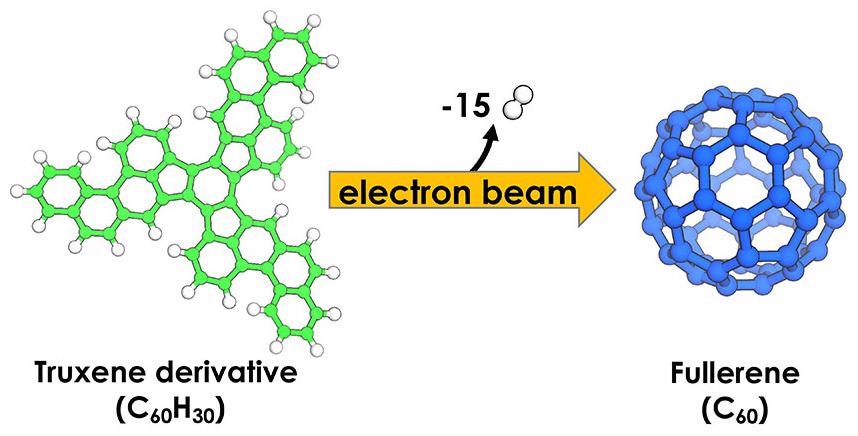May 25 2021
From the time molecular reactions were estimated and the existence of molecules was demonstrated, human beings have always wanted to visually watch the way these events continue.
 The chemical reaction of truxene derivative to fullerene C60. Image Credit: Institute for Basic Science.
The chemical reaction of truxene derivative to fullerene C60. Image Credit: Institute for Basic Science.
These observations of single-molecule reactions are extremely crucial for the fundamental interpretation of chemical sciences, which would support the development of innovative materials, catalysts, or medications, and help humans decode the intricate biochemical processes.
But this proved to be impossible for the longest period in contemporary chemistry, and to date, the data of nanoscale dynamical processes was acquired only from indirect techniques because molecules were extremely tiny to be observed.
But latest discoveries made by scientists from the Center for Nanomedicine within the Institute for Basic Science, South Korea, along with investigators from Germany and Japan could have just changed this.
The researchers were able to visualize the bottom-up synthesis of fullerene C60—an allotrope of carbon resembling a soccer ball—and created a video image that described the process through single-molecule atomic resolution real-time electron microscopy (SMART-EM).
This was successfully realized with the establishment of the conditions for overcoming subnanometer-sized objects, including molecules and even solitary atoms, and the introduction of aberration-corrected transmission electron microscopy (TEM).
During their experiment, the investigators worked with a customized truxene derivative (C60H30)—whose shape resembles a flat-pressed soccer ball—as the preliminary material.
For the TEM analysis, the truxene was attached to a graphene monolayer, which inhibits the molecule from being rapidly translated across the surface or even prevents the detachment into the vacuum.
By isolating a single molecule on the surface, the researchers were able to assess the dynamic processes without any disruption from other molecules. They subsequently irradiated this flat 2D material with an extremely powerful electron beam of up to 80,000 V, which is many times higher than the voltage found in electrical outlets used in homes.
But what happens to the molecule when it is subjected to this energetic electron beam? If this molecule obeys the rules of traditional organic chemistry textbooks, the adverse condition will drive the truxene to lose its hydrogen through a process called cyclodehydrogenation.
This process causes the residual carbon atoms inside the molecule to fold up in the form of a spherical shape.
However, if high-energy pathways were to dominate, the outcome will be an unforeseeable decomposition up to the entire atomization of the molecule.
By highly correlating the real TEM images with those of replicated models, the team noted that the truxene molecule first goes through a thermodynamically and kinetically regulated cyclodehydrogenation reaction.
The TEM analyses also demonstrated that the reaction pathway takes place through thermodynamically preferred key intermediates via apparently traditional organic reaction mechanisms. These mechanisms were later detected and recorded on video.
The researchers, thus, demonstrated that the beam of electrons sends kinetic energy to the nuclei and activates the molecular vibrational states, providing the molecule with enough energy to go through chemical reactions.
Most significantly, it was observed that the cross-section, or probability, for the traditional chemical pathway is bigger than that for the C–H bond cleavage, which is destructive.
For the first time, these results explain the real-time and real-space analysis of a distinct molecule-to-molecule transformation, recorded on video.
This real-space visualization of a distinct chemical reaction is a breakthrough in the field of chemical sciences and will provide a deeper insight into the underlying nanoscale chemical processes. Moreover, identification of the major intermediates sheds more light on reactions driven by the electron beam.
The team has planned to investigate the whole scope of the SMART-EM method by using it on bigger systems, like the analysis of liquid media. This will additionally advance the study in the domains spanning from biomedical sciences to nanomaterials chemistry in which a better understanding of the interactions between the beam and matter is highly significant.
The understanding gained from these analyses will also allow scientists to develop new strategies to produce nanomaterials with the help of electron beam lithography.
Journal Reference:
Lungerich, D., et al. (2021) A Singular Molecule-to-Molecule Transformation on Video: The Bottom-Up Synthesis of Fullerene C60 from Truxene Derivative C60H30. ACS Nano. doi.org/10.1021/acsnano.1c02222.